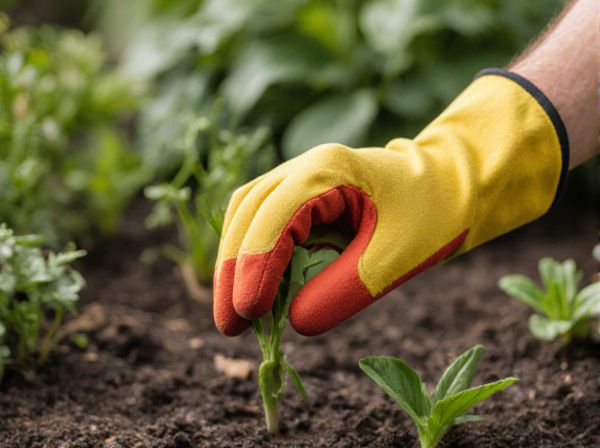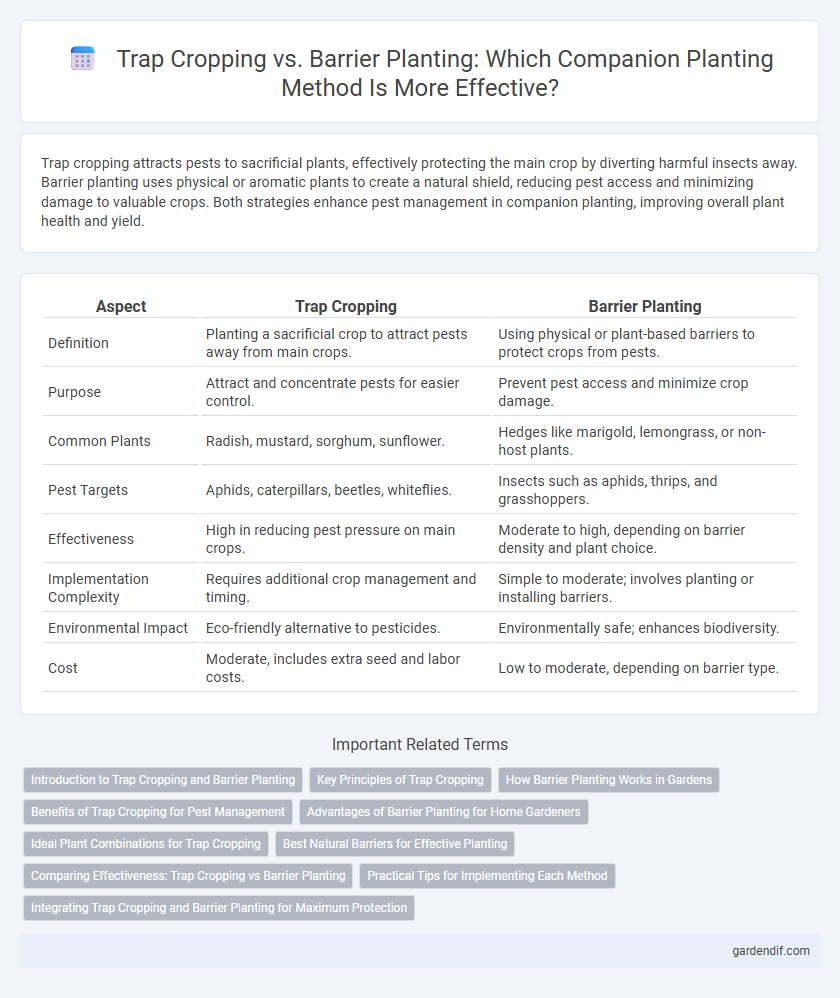
Trap cropping vs barrier planting Illustration
Trap cropping attracts pests to sacrificial plants, effectively protecting the main crop by diverting harmful insects away. Barrier planting uses physical or aromatic plants to create a natural shield, reducing pest access and minimizing damage to valuable crops. Both strategies enhance pest management in companion planting, improving overall plant health and yield.
Table of Comparison
| Aspect | Trap Cropping | Barrier Planting |
|---|---|---|
| Definition | Planting a sacrificial crop to attract pests away from main crops. | Using physical or plant-based barriers to protect crops from pests. |
| Purpose | Attract and concentrate pests for easier control. | Prevent pest access and minimize crop damage. |
| Common Plants | Radish, mustard, sorghum, sunflower. | Hedges like marigold, lemongrass, or non-host plants. |
| Pest Targets | Aphids, caterpillars, beetles, whiteflies. | Insects such as aphids, thrips, and grasshoppers. |
| Effectiveness | High in reducing pest pressure on main crops. | Moderate to high, depending on barrier density and plant choice. |
| Implementation Complexity | Requires additional crop management and timing. | Simple to moderate; involves planting or installing barriers. |
| Environmental Impact | Eco-friendly alternative to pesticides. | Environmentally safe; enhances biodiversity. |
| Cost | Moderate, includes extra seed and labor costs. | Low to moderate, depending on barrier type. |
Introduction to Trap Cropping and Barrier Planting
Trap cropping involves planting specific crops to attract pests away from main crops, effectively reducing pest damage by diverting harmful insects. Barrier planting uses physical or plant-based barriers to block or deter pests from reaching the primary crops, creating a protective boundary. Both techniques enhance integrated pest management by minimizing chemical pesticide use and promoting sustainable agriculture.
Key Principles of Trap Cropping
Trap cropping involves planting a specific crop to attract pests away from the main crop, reducing damage and minimizing pesticide use. Key principles include selecting a highly attractive trap crop, synchronizing planting times to ensure the trap crop matures before the primary crop, and positioning the trap crop strategically to intercept pests. Effective trap cropping enhances pest management by exploiting pest behavior and life cycles, promoting sustainable agricultural practices.
How Barrier Planting Works in Gardens
Barrier planting involves strategically placing certain plants around garden beds to create a natural physical or chemical obstacle that deters pests from reaching valuable crops. Plants like marigolds, nasturtiums, or aromatic herbs emit odors or contain compounds that repel insects, effectively reducing pest infestation while promoting healthier growth of target plants. This method enhances integrated pest management by minimizing the need for chemical pesticides and maintaining ecosystem balance.
Benefits of Trap Cropping for Pest Management
Trap cropping effectively attracts pests away from main crops by using sacrificial plants, reducing pest damage and minimizing the need for chemical pesticides. This technique enhances biodiversity and supports natural predator populations, promoting a healthier ecosystem within the garden or farm. Trap cropping can lead to increased crop yields and improved pest control efficiency, making it a sustainable and eco-friendly pest management strategy.
Advantages of Barrier Planting for Home Gardeners
Barrier planting effectively deters pests by creating a physical or olfactory boundary around valuable garden plants, reducing the need for chemical interventions in home gardens. Its targeted protection enhances plant health and yield by preventing pest access, making it a sustainable and low-maintenance pest management strategy. Home gardeners benefit from barrier planting through improved crop quality and minimized pest damage, fostering an eco-friendly gardening environment.
Ideal Plant Combinations for Trap Cropping
Ideal plant combinations for trap cropping include pairing pest-attracting species such as mustard or radish with main crops like cabbage or tomatoes, effectively luring pests away from valuable plants. Planting trap crops along the perimeter or interspersed within main crops maximizes pest interception, reducing damage without chemical intervention. This strategy optimizes pest management by leveraging specific plant traits that attract and hold pests, enhancing sustainable agricultural practices.
Best Natural Barriers for Effective Planting
Effective companion planting relies on selecting the best natural barriers to enhance crop protection and yield. Trap cropping uses sacrificial plants like mustard or radish to attract pests away from main crops, while barrier planting employs dense hedges or tall grasses such as millet or sorghum to physically block pest movement. Prioritizing native species and fast-growing plants ensures sustainable and eco-friendly pest management in agricultural systems.
Comparing Effectiveness: Trap Cropping vs Barrier Planting
Trap cropping attracts pests away from main crops by using sacrificial plants, effectively reducing pest populations in targeted areas. Barrier planting involves creating physical or biological barriers that deter pests from reaching the main crops, enhancing crop protection without sacrificing additional plants. Studies show trap cropping excels in managing specific pest species, while barrier planting offers broader pest deterrence with less crop sacrifice, making each method uniquely effective depending on pest behavior and farm layout.
Practical Tips for Implementing Each Method
Trap cropping involves planting a preferred crop variety around a main crop to attract pests away, requiring careful selection of highly attractive trap plants and regular monitoring to remove pests before they spread. Barrier planting uses dense rows of non-host plants or physical barriers to prevent pests from reaching the main crop, emphasizing the importance of proper spacing and timely planting to maximize effectiveness. For both methods, integrating pest scouting and adjusting plant placement based on pest behavior improves overall pest management success.
Integrating Trap Cropping and Barrier Planting for Maximum Protection
Integrating trap cropping and barrier planting maximizes pest management efficiency by attracting pests to sacrificial plants while physically blocking their access to main crops. This combined approach enhances crop protection through strategic placement of trap crops alongside barrier plants, reducing pest migration and damage significantly. Implementing this dual strategy supports sustainable agriculture by minimizing pesticide use and promoting biodiversity.
Trap cropping vs barrier planting Infographic

 gardendif.com
gardendif.com